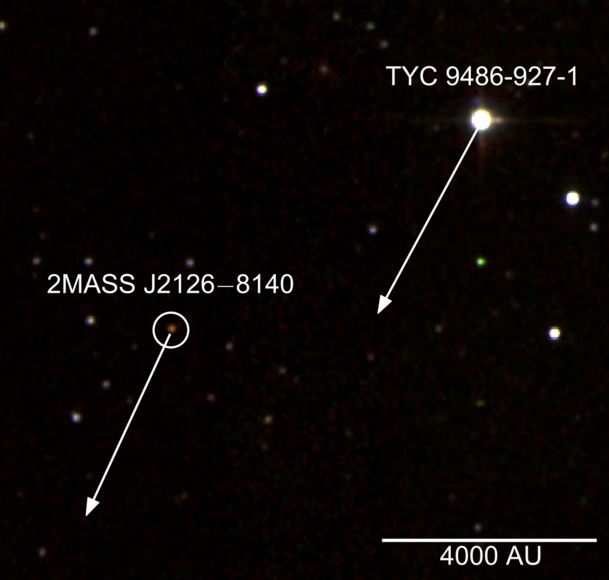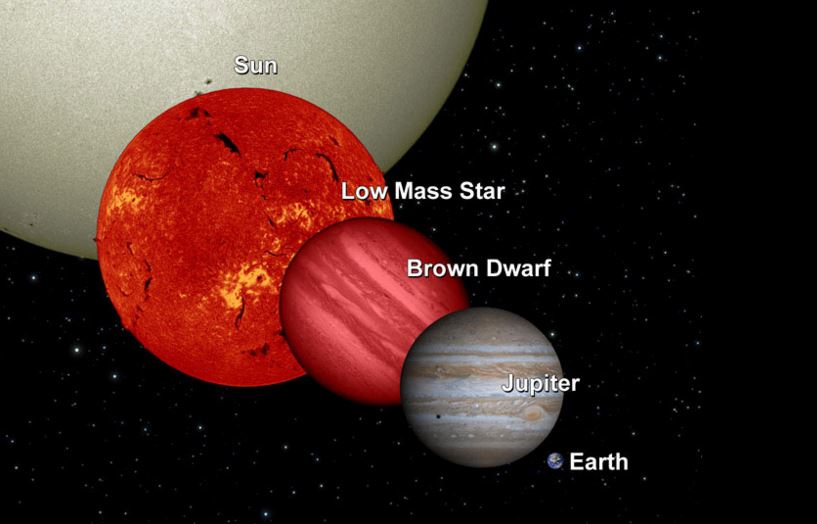A lonely planet one trillion kilometres from its star in a mega huge solar system was found by a team of British, American and Australian astronomers. The amazing object, called 2MASS J2126, is about seven thousand times further from its star than the Earth is from the Sun.
The astronomers, who wrote about their study and conclusions in the academic journal Monthly Notices of the Royal Astronomical Society (citation below), said the object had initially been thought to be free-floating, i.e. it did not orbit a star.
Over the past five years, several free-floating planets have been discovered. They are huge gas giant worlds like Jupiter that do not have the mass for the nuclear reactions that make stars shine brightly – over time they cool and fade.
 An artist’s impression of 2MASS J2126. (Image: ras.org.uk. Credit: University of Hertfordshire/Neil Cook)
An artist’s impression of 2MASS J2126. (Image: ras.org.uk. Credit: University of Hertfordshire/Neil Cook)
The authors said that measuring the temperature of these planets is fairly straightforward, but it depends on both age and mass. This means that scientists need to find out their age before they can determine whether they are lightweight enough to be planets or whether they are brown dwarfs – substellar objects not massive enough to sustain hydrogen-1 fusion reactions in their cores, unlike main-sequence stars, i.e. failed stars.
Initially thought to be a free-floating planet
The object was found by US-based researchers in an infrared sky survey. They flagged it as perhaps a young and hence low-mass object. In 2014, a team of Canadian astronomers identified 2MASS J2126 as a possible member of the Tucana Horologium Association – a 45-million-year-old group of stars and brown dwarfs. This made it young enough and with sufficiently low mass to be classified as a free-floating planet.
In the same region of the sky, TYC 9486-927-1 is a star that scientists have identified as being young, but is not a member of any group of young stars we know of. Before this study, nobody had suggested that 2MASS J2126 and TYC 9486-927-1 were in any way linked.
Lead author, Dr. Niall Deacon, a Postdoctoral Researcher in the Centre for Astrophysics Research at the University of Hertfordshire in England, has spent the past few years scouring the skies for young stars with companions in wide orbits.
 False colour infrared image of 2MASS J2126 and TYC 9486-927-1. The arrows show the projected movement of the star and planet on the sky over a period of 1000 years. The scale indicates a distance of 4000 Astronomical Units (AU. One AU = 1 Earth-Sun distance). (Image: ras.org.uk. Credit: 2MASS/S. Murphy/ANU)
False colour infrared image of 2MASS J2126 and TYC 9486-927-1. The arrows show the projected movement of the star and planet on the sky over a period of 1000 years. The scale indicates a distance of 4000 Astronomical Units (AU. One AU = 1 Earth-Sun distance). (Image: ras.org.uk. Credit: 2MASS/S. Murphy/ANU)
As part of the work, Dr. Deacon and colleagues sifted through lists of brown dwarfs, free-floating planets, and young stars to see whether any of them might be related.
They found that 2MASS J2126 and TYC 9486-927-1 are travelling through space together and are both approximately 104 light years from our Sun, suggesting that they are associated.
Widest planetary system discovered so far
Dr. Deacon said:
“This is the widest planet system found so far and both the members of it have been known for eight years, but nobody had made the link between the objects before. The planet is not quite as lonely as we first thought, but it’s certainly in a very long distance relationship.”
After studying them in more detail, the scientists could not confirm that 2MASS J2126 and TYC 9486-927-1 are members of any group of young stars we know of.
 Most brown dwarfs are only slightly bigger than Jupiter (10–15%) but up to 75 times heavier due to greater density. (The Sun is not to scale). (Image: Wikipedia)
Most brown dwarfs are only slightly bigger than Jupiter (10–15%) but up to 75 times heavier due to greater density. (The Sun is not to scale). (Image: Wikipedia)
Co-author Josh Schlieder, a NASA Postdoctoral Program Fellow at NASA Ames Research Center in Moffett Field, California, said:
“Membership in a group of young stars is great for establishing an age, but when we can’t use that we need to resort to other methods.”
The researchers then looked at the spectrum – the dispersed light – of the star to measure the strength of a feature caused by lithium. The element lithium is destroyed when a star is young. Very young stars have more lithium than their slightly older counterparts.
Stronger lithium signatures were detected in TYC 9486-927-1 than in the Tucana Horologium Association (45 million year old stars). However, the signatures were weaker than in a group of 10 million year old stars, suggesting it was between 10 and 45 million years old.
Based on this age, the astronomers could then estimate the mass of 2MASS J2126, and found it to be from 11.6 to 15 times the mass of Jupiter – a goliath of a planet.
This placed it on the borderline between brown dwarfs and planets. This means that 2MASS J2126 has a similar temperature, age and mass to one of the first planets directly imaged around another star – beta Pictoris b.
A super-wide planetary system
Co-author Dr. Simon Murphy, a SkyMapper Postdoctoral Fellow at the Australian National University’s Research School of Astronomy & Astrophysics in Canberra, said:
“Compared to beta Pictoris b, 2MASS J2126 is more than 700 times further away from its host star, but how such a wide planetary system forms and survives remains an open question.”
2MASS J2126 is approximately 1 trillion kilometres or 7000 Earth-to-Sun distances from its parent star. It has the widest orbit of any planet in the Universe we know about.
One year on this planet is equivalent to 900,000 Earth years, i.e. every time 2MASS J2126 completes one orbit around its star, Earth has done 900,000 orbits around the Sun. This means that it has completed fewer than fifty orbits since it was born.
The chances of any life forms existing on the planet are extremely remote, but if there were any, they would see their ‘Sun’ as just a bright star in the sky, and would not even imagine they were connected to it in any way.
Citation: “A nearby young M dwarf with a wide, possibly planetary-mass companion,” N.R. Deacon, J.E. Schlieder & S.J. Murphy. Monthly Notices of the Royal Astronomical Society. 16 January 2016.
